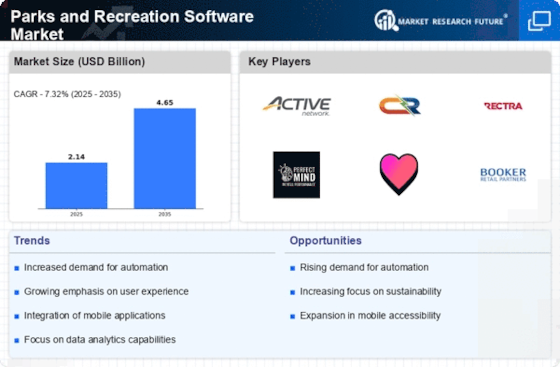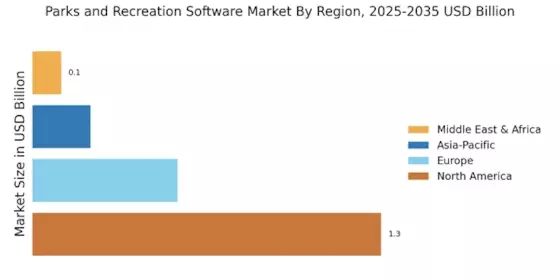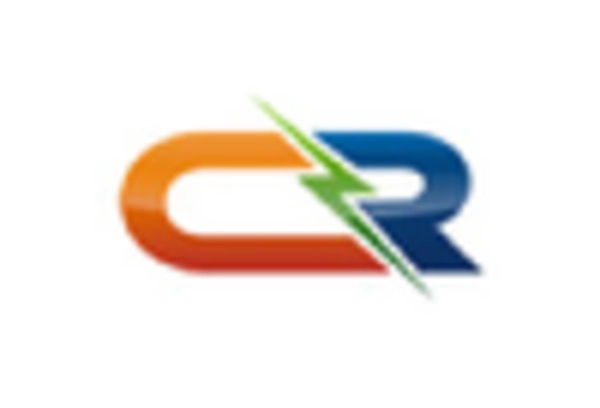Focus on Sustainability
Sustainability has emerged as a critical driver within the Parks and Recreation Software Market. As environmental concerns gain prominence, parks and recreation departments are increasingly adopting software solutions that facilitate sustainable practices. This includes features that help track resource usage, manage waste, and promote eco-friendly initiatives. For example, software that assists in planning and managing green spaces can significantly contribute to urban sustainability efforts. Recent statistics indicate that over 70% of parks and recreation agencies are now implementing sustainability measures, which in turn drives the demand for software that supports these initiatives. The integration of sustainability-focused features not only aligns with community values but also enhances the overall appeal of parks and recreation programs, thereby potentially increasing participation rates.
Integration of Advanced Technologies
The Parks and Recreation Software Market is experiencing a notable shift towards the integration of advanced technologies such as artificial intelligence, machine learning, and data analytics. These technologies enhance operational efficiency and improve user experience by providing insights into usage patterns and resource allocation. For instance, predictive analytics can help parks and recreation departments forecast demand for facilities and programs, thereby optimizing scheduling and resource management. As municipalities increasingly seek to modernize their operations, the adoption of these technologies is likely to drive growth in the Parks and Recreation Software Market. Furthermore, the ability to leverage mobile applications and cloud-based solutions allows for real-time updates and accessibility, which is becoming essential in meeting the expectations of tech-savvy users.
Customization and User-Centric Design
Customization and user-centric design are pivotal drivers in the Parks and Recreation Software Market. As diverse communities have unique needs, software solutions that offer tailored functionalities are in high demand. This trend is reflected in the increasing number of software providers that allow for customizable modules, enabling parks and recreation departments to adapt the software to their specific requirements. According to recent data, approximately 65% of parks and recreation agencies prioritize user-friendly interfaces and customizable features when selecting software solutions. This focus on personalization not only enhances user satisfaction but also improves engagement with community members, thereby fostering a more active participation in local programs and activities. The ability to cater to specific user needs is likely to remain a key factor in the competitive landscape of the Parks and Recreation Software Market.
Enhanced Data Management and Reporting
Enhanced data management and reporting capabilities are becoming increasingly vital in the Parks and Recreation Software Market. As agencies strive to improve transparency and accountability, the demand for software that offers robust data collection and reporting tools is on the rise. These tools enable parks and recreation departments to track participation rates, program effectiveness, and financial performance, thereby facilitating informed decision-making. Recent data suggests that agencies utilizing advanced reporting features experience a 30% increase in operational efficiency. Furthermore, the ability to generate comprehensive reports not only aids in internal assessments but also enhances communication with stakeholders and the community. As the emphasis on data-driven decision-making continues to grow, the demand for sophisticated data management solutions within the Parks and Recreation Software Market is likely to expand.
Increased Funding for Parks and Recreation
Increased funding for parks and recreation initiatives is a significant driver in the Parks and Recreation Software Market. As communities recognize the importance of recreational spaces for public health and well-being, there has been a marked increase in budget allocations for parks and recreation departments. This trend is supported by various government initiatives aimed at enhancing community engagement and promoting active lifestyles. Recent reports indicate that funding for parks and recreation has risen by approximately 15% over the past few years, which directly correlates with the demand for advanced software solutions. With more resources available, agencies are more inclined to invest in technology that streamlines operations and enhances service delivery. This influx of funding is likely to propel the growth of the Parks and Recreation Software Market, as agencies seek to modernize their systems and improve community offerings.


















Leave a Comment